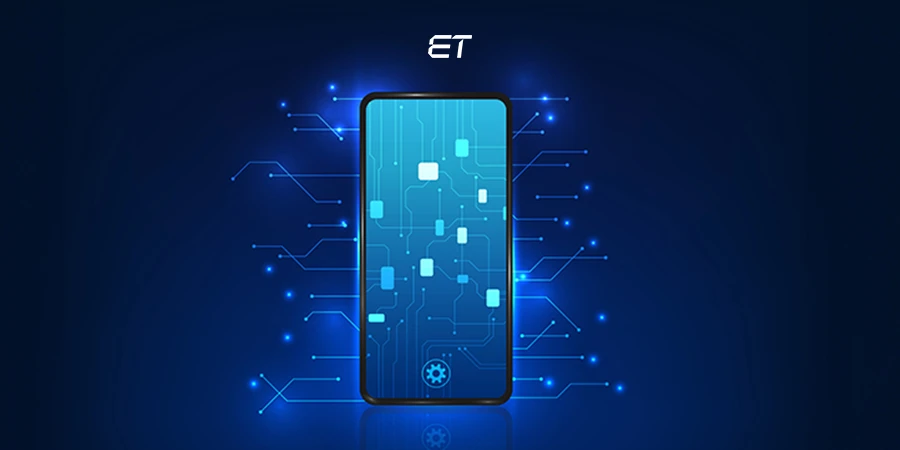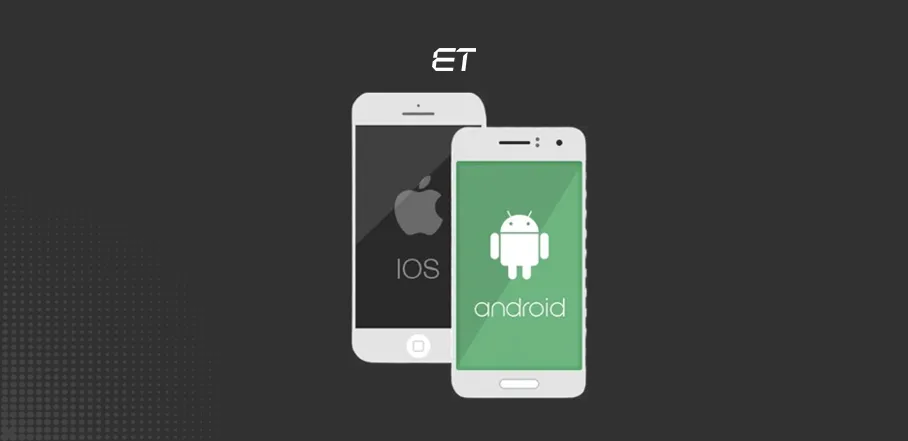
iPhone Users vs Android Users: An Intriguing Comparison and Stats
Some face-offs remain eternal. Be it PC vs Mac, X-box vs Nintendo, or iPhone users vs Android users. As a business, you must look at them from a neutral perspective.
By 2029, the global smartphone market can surpass the USD 790 billion mark. So, be it iOS or Android, you can leverage any platform after understanding the nuances between them.
This blog will decode the essential stats and facts of Android vs iPhone users. This information can help in creating apps that meet the expectations and demands of the two user categories. So, scroll ahead to acquaint yourself with iPhone vs Android users differences.
Partner with App Store award-winning developers. Build your next dream project with us!
iPhone Users vs Android Users: Market Share Worldwide

Let’s proceed one by one. First, understand the influence of Apple smartphones in the world:
- Number of iPhone users: 1.56 billion (approx.)
- Global market share: 29%
- iPhone Users in the US: 151 million (approx.)
Now, let’s decode the same statistics to understand the Android market share:
- Number of Android users: 4.2 billion (approx.)
- Global market share: 48%
- Android Users in the US: 155 million (approx.)
The iPhone users vs Android users face-off gives one universal fact. Across the globe, you will find more Android users than their iPhone counterparts. However, there are large numbers of iOS users in certain countries like the US.
So, as a business, you need to thoroughly understand such figures before developing an app.
iPhone vs Android: Market Share in the US
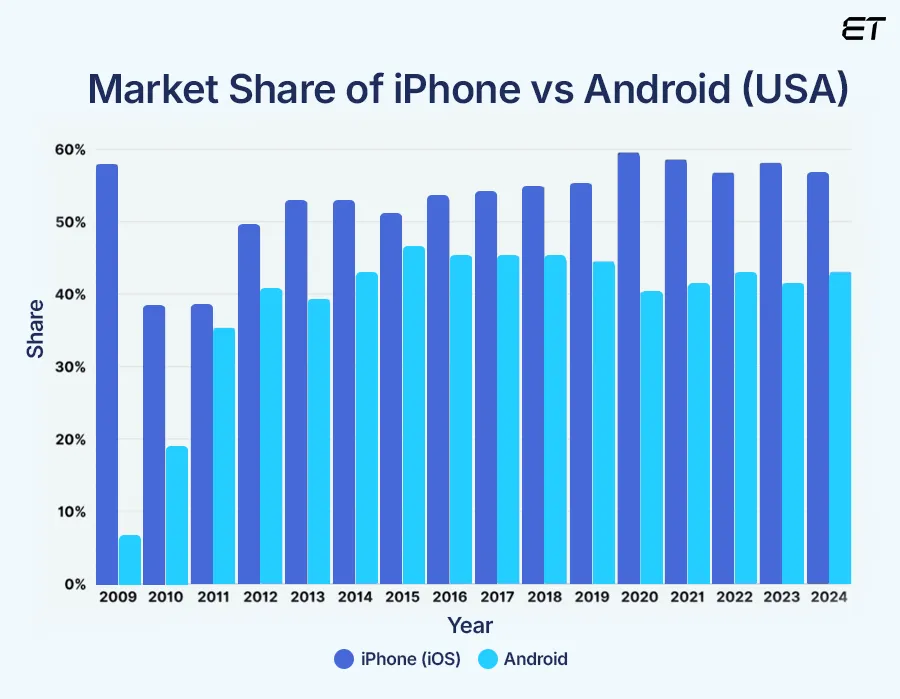
Let’s zoom in on the United States of America. Here’s how the numbers stack up:
- iPhone users in the US: 130 million (approx.)
- Android users in the US: 133.4 million (approx.)
- iPhone market share (US): 58.6%
- Android market share (US): 41.1%
As you can see, the US paints a unique picture compared to the global scene. While Android might dominate worldwide, Apple holds a significant (and in some cases, leading) share of the American smartphone market.
This means one thing for businesses. If your target audience is US-based, iOS deserves serious attention. From app design to monetization strategy, you may need to prioritize Apple’s ecosystem to connect with your users effectively.
That said, Android isn’t far behind. So if inclusivity is key, cross-platform development might be your safest bet.
iPhone vs Android Users: A Look at the Technical Differences
Both smartphone ecosystems provide a different experience to their target audience. In this section, we will try to explain why there is a divide between iPhone and Android users worldwide.
1. Operating System

iPhone is a product of Apple whereas Android is a product of Google. The iPhone runs on iOS whereas Android phones run on an operating system with the same name.
Prominent names like Samsung, Motorola, Vivo, OnePlus, and Oppo use Android as the OS for their smartphones. Now, in the case of iPhone users vs Android users, here are the points that will prove useful.
| iPhone Users’ View of the Operating System | |
| Value the simplicity | Prefer the curated selection of apps |
| Enjoy the seamless integration | Like the regular security updates |
| Praise security measures | Appreciate the minimal design |
Let’s move on to understanding the general views of Android users about their OS.
| Android Users’ View of the Operating System | |
| Praise the open ecosystem | Prefer the flexibility aspect |
| Enjoy the customizable interface | Prioritize brands with consistent updates |
| Value the wide variety of apps | Appreciate the ease of compatibility |
As you can notice, there is no clear winner. These are two user categories with different priorities. So, when developing your company’s app, ensure you understand the needs of your target audience.
2. Hardware
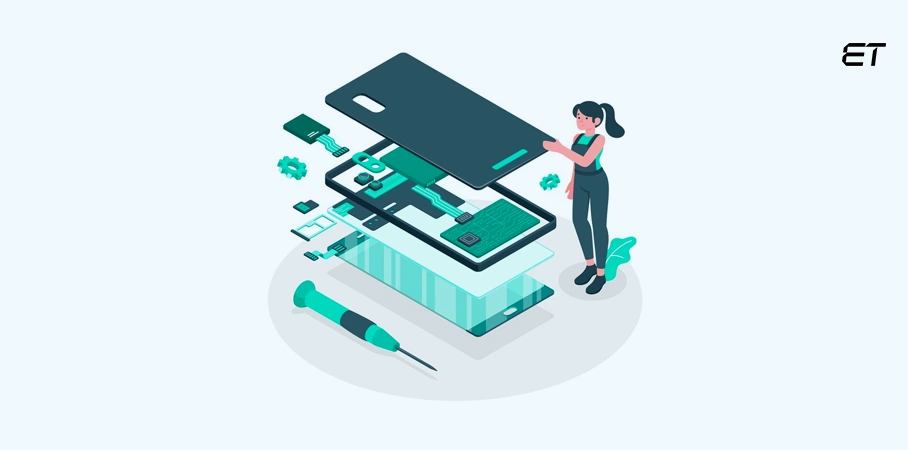
Let’s understand the hardware perspective of each user category. First, we will cover what Apple users feel about their devices.
| iPhone Users’ View of the Hardware | |
| Adore the premium build quality | Prefer the strong battery life |
| Enjoy using the top-tier cameras | Appreciate the vibrant displays |
| Value the powerful processors | Don’t bother with limited customization |
On the other hand, Android users have slightly different perception regarding their smartphones.
| Android Users’ View of the Hardware | |
| Utilize the expandable storage | Prefer the innovative features |
| Prefer the wide variety of choices | Appreciate the headphone jack |
| Like the diverse form factors | Can ignore the build quality |
So, the comparison of iPhone users vs Android users gives us an understanding of the audience outlook. iPhone users prefer a comparatively premium feel. On the other hand, Android users want a good bang for their buck.
3. Spending Patterns

These days, the gap between iPhone and Android smartphones in terms of premium build is diminishing. For instance, you can buy flagship smartphones from a brand like Samsung at a decent price. However, in general terms, iPhone users are willing to pay for various premium offerings like paid apps and subscriptions.
Here’s a general lookout.
| iPhone Users’ Spending Patterns | |
| More willing to spend on premium devices | Exhibit strong brand loyalty |
| Can make in-app purchases | Have a higher spending probability |
| Prone to invest in other Apple products | Are less price-sensitive |
On the contrary, here are a few points to consider regarding Android users.
| Android Users’ Spending Patterns | |
| Prioritize value-for-money | The spending habits are variable |
| Benefit from competitive pricing | Are more open to trade-ins |
| Can spend on accessories | Focus on value-driven purchases |
All in all, iPhone users are more willing to utilize their money for higher-priced devices and services. Android users, on the other hand, are more price-conscious (generally).
4. Application Store

From a business perspective, the iPhone users vs Android users comparison is more relevant in terms of the application market. iPhones have a dedicated ‘App Store’ for iOS apps, whereas Android smartphones have a specialized ‘Google Play Store.’ Let’s comprehend the outlook of the two user groups.
| iPhone Users’ View on the Application Store | |
| Like the curated app selection | Can enjoy the exclusive Apple apps |
| Adore the clean and intuitive interface | Benefit from the seamless integration |
| Prioritize the fewer malware instances | More likely to spend on in-app purchases |
Android users have a different perspective about the popular mobile operating system. Here are six points to consider.
| Android Users’ View on the Application Store | |
| Prefer the wider app selection | Like more available free apps |
| Can benefit from the open platform | Prioritize the wide range of software |
| Enjoy greater app installation flexibility | Can explore alternative app stores |
Overall, the application aspect in the iPhone users vs Android users comparison is straightforward. iPhone users prefer the closed and secure Apple ecosystem. On the other hand, Android users desire the flexibility and variety of the Google platform that allow a range of general and gaming apps.
Need the assistance of certified mobile app developers? Our mobile app development services are only a click away!
iPhone vs Android: Apps and Revenue
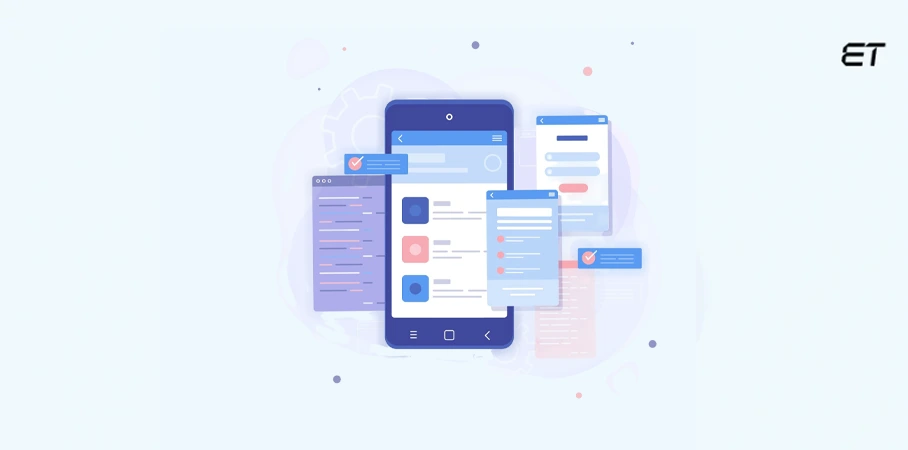
Take a look at these numbers:
- The Apple App Store has approx. 1.83 million apps
- The Android Google Play Store has approx. 3.95 million apps
As you can notice, the iPhone market has a selected number of applications. Your developed app needs approval from the review team for its final release.
On the contrary, Google Play Store is more open to experimentation and allows flexibility in terms of app design. So, the chances of being featured faster on the Android store are higher than on iOS.
- To publish your app on the App Store, you need to pay USD 99 per year
- For publishing an app on the Google Play Store, you need to a one-time registration fee of USD 25
In terms of revenue, the Apple App Store generated around USD 112 billion. Google Play Store generated USD 58 billion when you consider the wide array of Android devices.
Now, the following table presents a head-to-head comparison of the iPhone users vs Android users face-off:
| iPhone App Landscape | Android App Landscape |
| More streamlined ecosystem | Access to larger market share |
| Consistent user experience | Open and flexible development environment |
| Higher revenue per user | Challenges during device fragmentation |
| Primary languages are Swift or Objective-C | The primary languages are Kotlin or Java |
iPhone vs Android User Demographics and Behavior
It’s not just about how many users are on each platform, but who they are and how they behave. So, let’s peek behind the screens. Here’s what the data tells us about the typical user profiles:
- iPhone users tend to skew younger, with a strong presence in the 18 – 34 age group
- Android users are spread more evenly across all age groups, with a noticeable bump in the 45+ bracket
Income is another key differentiator:
- A higher percentage of iPhone users fall into the middle-to-high income bracket
- Android users dominate in lower and mid-income groups, partly due to the broader range of budget-friendly devices
And when it comes to location?
iPhone dominates in urban and suburban areas, while Android holds a solid lead in rural regions Now, let’s understand the usage behavior.
iPhone users tend to:
- Spend more on apps and in-app purchases
- Update to the latest iOS faster
- Prioritize privacy and security
- Engage more with premium services (Apple Pay, Apple Music, etc.)
Android users typically:
- Are more experimental with customization and third-party apps
- Prefer flexibility and control over device settings
- Use a wider variety of app stores and sources
- Show strong price sensitivity in app purchases
So, what this means for your business?
- Targeting younger, high-spending users? You might want to build for iOS first
- Going after a broader audience with diverse income levels? Android can offer scale and flexibility
If you want both? It’s time to embrace cross-platform development and meet users where they are.
Aspects to Consider When Choosing a Platform for Your Mobile App
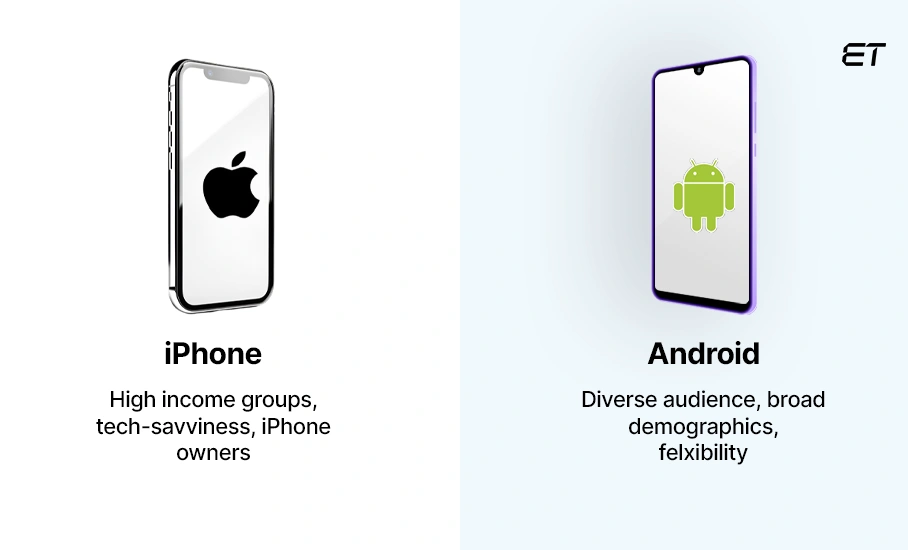
The statistics are clear. By now, you have a good idea of the user personas in the iPhone users vs Android users face-off. However, before tapping into a specific user group, you should consider a few practical aspects about Android and iPhone users.
- When to Choose iOS: Your target audience is high-income, tech-savvy, and owns iPhones
- When to Choose Android: Your target audience is diverse and belongs to broad demographics
Choosing between iOS and Android is about aligning your app’s goals with the right audience, tech stack, and monetization strategy. To make your decision easier, here’s a side-by-side breakdown of the key aspects you should consider.
| Aspect | iOS (iPhone) | Android |
| User Demographics | Younger, higher-income, urban users | Broader age and income range, strong rural and global presence |
| Market Share (US) | Higher (around 58%) | Lower (around 41%) |
| Global Reach | Strong in North America, Western Europe, and Japan | Dominant in Asia, Africa, South America |
| Development Cost | Typically higher due to stricter guidelines and fewer devices | More variation based on device fragmentation but often lower initial cost |
| Time to Market | Slower | Faster |
| Monetization Potential | Higher in-app revenue and purchases | Better for ad-based monetization due to larger global user base |
| Customization and Flexibility | Limited, tightly controlled ecosystem | Highly customizable—freedom in UI, features, and third-party integration |
| AI Feature Integration | Privacy-centric, native Apple Intelligence tools | More experimental and flexible with generative AI and voice assistance |
| Security and Privacy | Very high, frequent updates, strict permissions | Variable (depends on device brand and Android version) |
Covering all these facets of iOS and Android users increases your chance of developing successful mobile apps. If you want to develop an application that runs on both platforms, prefer the cross-platform approach. You can hire Flutter developers for this purpose.
iPhone vs Android User: AI Features and Latest Trends
Smartphones aren’t just smart anymore. They’re getting clever, predictive, and intuitive. Let’s unpack how iPhone and Android users are experiencing the future right in their pockets.
AI Features: A Quick Comparison
Both platforms are racing to out-intelligence each other. Here’s where things stand:
iPhone (iOS) users now enjoy features like:
- Apple Intelligence (iOS 18+): A suite of on-device AI tools for writing suggestions, smart photo editing, and contextual Siri responses
- Personalized Siri: Smarter, more privacy-focused voice interactions
- Live Voicemail and Smart Summaries: AI filters what’s important without you lifting a finger
Android (Google Pixel and others) users see:
- Google Assistant + Gemini AI: Context-aware help, advanced summarizing, and real-time task execution
- Magic Editor in Photos: Remove objects, shift subjects, change skies—like Photoshop in your pocket
- Call Screening and AI Transcripts: Real-time spam filtering and live transcriptions
iPhone users are more likely to use built-in AI features, thanks to Apple’s tight ecosystem and trust in privacy. On the other hand, Android users, especially on Pixel and Samsung, are early adopters of generative AI tools, using them for photo edits, writing prompts, and daily tasks.
Trends to Watch
Here are some cool artificial intelligence trends in these devices that need your attention:
- On-device AI is the next big wave reducing latency, boosting privacy, and enabling smarter personalization
- Generative AI in messaging apps (think auto-reply, tone adjustment, or emoji recommendations) is gaining traction
- AI-enhanced accessibility voice commands, real-time captions, and screen readers—are transforming usability for all
So, if you’re building apps for the AI-first generation:
- On iOS, lean into Apple’s privacy-first AI and consider using native APIs for summarization, voice, and content suggestions
- On Android, especially Pixel and Samsung devices, you can go bolder—think AI-enhanced UX, real-time prompts, and contextual user actions
In short: both platforms are evolving fast. Your app doesn’t need to predict the future, but it should align with the target use of the audience.
Wrapping Up
The iPhone users vs Android users isn’t a comparison that’ll produce any winner. Both groups have distinct preferences and priorities. So, as a business, you need to understand the user requirements before capitalizing on a specific smartphone market.
iPhone users tend to value the premium build, seamless Apple integration, and a clean user interface. On the other hand, Android users prefer the variety, flexibility, and value-for-money aspects. In the case of market share, Android has a greater global presence. However, Apple is more dominant in regions like the US, Canada, Australia, the UK, and Sweden.
Consider the option of cross-platform development if you want your app to be featured on both platforms. After all, leveraging the growing smartphone market can always generate high ROI for your business.
Build cross-platform apps with confidence. Send in your requirements and let’s collaborate!





